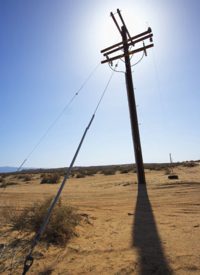
BrightSource Energy, headquartered in Oakland, California, is developing the $2 billion Ivanpah Solar Electric Generating System (ISEGS) in the Mojave Desert — the first large-scale solar thermal project built in the Golden State in nearly two decades. Once constructed, it will be the largest in the world, possibly doubling the amount of U.S.-produced commercial solar thermal electricity.
However, first the company will have to relocate the nearby desert tortoises. It seems the garage-door-sized mirrors — 347,000 of them — will displace the animals. But that’s only one hurdle to be surmounted.
Environmentalists oppose the project’s impact on all surrounding wildlife, including the desert tortoise, and may sue to stop construction. But other, larger obstacles, like the transmission lines that must be built to carry power to the cities, and the uncertainty of obtaining federal dollars, are more difficult to resolve. An October 28 New York Times article observes:
[The ISEGS] is the first of nine multibillion-dollar solar farms in California and Arizona that are expected to begin construction before the end of the year as developers race to qualify for tens of billions of dollars in federal grants and loan guarantees that are about to expire.
And … without continued government incentives, reducing the risk to investors, solar companies’ plans for more plants may not be able to raise enough capital to proceed.
BrightSource’s website describes the ISEGS as "comprised of three separate plants to be built between 2010 and 2013 starting this fall. The electricity generated by all three plants is enough to serve more than 140,000 homes in California during the peak hours of the day," noting that the complex is "located … on federal land managed by the Bureau of Land Management."
Solar thermal energy is a technology for harnessing solar energy for thermal energy, differing from photovoltaics, which converts solar energy directly into electricity. But the use of solar power, thermal or otherwise, is not as reliable as purported. Maintenance proves to be a problem and the savings aren’t realized in actual applications.
The Times article continues:
Solar developers depend on two federal programs to make their projects financially viable. The most crucial is a loan guarantee program, expiring next September, that allows them to borrow money on favorable terms to finance up to 80 percent of construction costs.
The other is the option to take a 30 percent tax credit in the form of a cash payment once a project is built. Although the tax credit does not expire until the end of 2016, the option to take it as a cash payment disappears this year, making it far less valuable to a start-up company that is just beginning to generate revenue. [As in the case of wind-turbine construction, the government subsidies and tax credits are probably the overriding factor in building the solar plants. [See Wind Power II: The Wind-farm Eruption.]
With both Democrats and Republicans promising to rein in the federal budget, it is unclear whether lawmakers will extend the programs in any form. Ivanpah is the first California project to win a government loan guarantee. In that cash-strapped state, suffering from high unemployment, this and eight other projects will create an estimated 8,000 jobs; 1,000 employees will be needed during the three-year construction phase. (But there is no mention of how many jobs will be lost because of the increased cost of energy to businesses.)
One factor driving ISEGS and other solar projects is the state’s mandate that California utilities obtain a third of their electricity from renewable sources by 2020. However, in other areas of the country where green power is offered, it doesn’t always work.
For instance, though Austin, Texas energy customers are given a choice to purchase “green energy,” few (even in a city full of environmentalists) have taken advantage of that more expensive option. Nathaniel Bullard, solar analyst at Bloomberg New Energy Finance, claims that California’s gas-fueled plants can produce electricity for about 10 cents/kilowatt hour, and (after including government subsidies) it’s expected that the state’s solar thermal plants can produce it at 13-17 cents/kilowatt-hour. The industry says that’s close enough to be competitive. But in Austin, consumers don’t buy it.
Bullard continued, “Without the Department of Energy coming in to assume a lot of the risk, you might not find lenders willing to lend, particularly if you’re a start-up with untried technology.”
Other solar projects — Tessera Solar in Houston, and two in California: Solar Millenium and Solar Trust of America — are seeking loan guarantees totaling 12.5 billion. Uwe T. Schmidt, chairman of Solar Trust of America, told the New York Times, "We’re seeing that the loan guarantee is an absolute necessity for building some of these larger projects."
The use of solar energy is still unreliable and expensive, and with the economic climate as grossly unbalanced as it is, government-guaranteed loans for large projects with dubious benefits are irresponsible.
Decisions about energy production and consumption are better left in the hands of the private sector.



